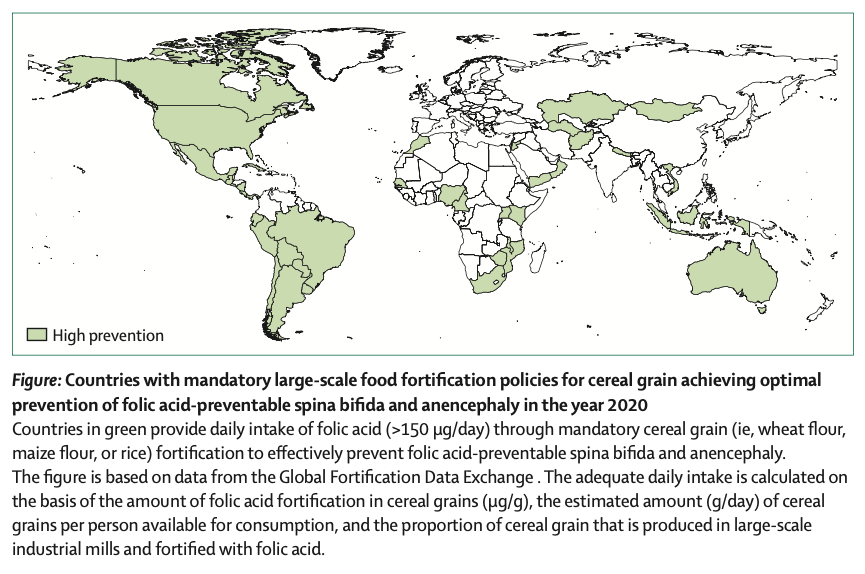What's the fuss about folic acid?

What if a simple intervention that cost net zero and didn’t require any behaviour change could halve the prevalence of life-threatening conditions? Enter the story of folic acid versus not one, but two disorders, spina bifida and anencephaly.
Both are relatively common birth defects that involve a mis-forming of the early development of the brain and spinal cord that arise from the neural tube, and are therefore referred to as neural tube defects (NTDs). They occur early in pregnancy, and have devastating effects. In spina bifida the spinal cord does not close properly and forms a protrusion which can be seen on the back and although neurosurgeons can close the defect, the condition usually causes other problems such as weakness of the legs, poor bowel and bladder control, hydrocephalus (a build up of water in the brain), and learning difficulties.
With the appropriate multidisciplinary care, children (and adults) with spina bifida may enjoy an excellent quality of life, but this can also place a heavy socio-economic burden on families.
In anencephaly, the most severe NTD, the baby is born with an incomplete skull and exposed, abnormally formed brain. This is a very distressing condition to deal with, and affected babies typically die before birth or survive only a short time after birth.
It is estimated that the prevalence of NTDs was 2.5 per 1000 live births for South Africa pre 2003, lower in urban settings and higher in rural settings.
Why 2003? That was the year South Africa implemented nation-wide folic acid (or Vitamin B6) fortification of key foods to address this micronutrient deficiency in the population. And it worked! NTDs declined by a whopping 65.9%.

It would therefore seem that fortification with folic acid is an effective solution to combatting these disorders. When comparing countries that have implemented fortification of foods such as cereals and grains- including South Africa, the USA, Australia, and Brazil - the decline in NTDs before and after folic acid fortification is dramatic. Brazil’s rate of NTDs decreased from 17.6 to 11.4 per 10 000 births, Australia’s rate dropped from 24.3 to 8.2 per 10 000 births and the USA’s from 7.1 to 5 per 10 000 births.
It is scarcely believable that such a complex condition can be prevented by something as simple as a vitamin!
How do the costs associated with implementing folic acid fortification compare to the medical costs of the disorders? Kancherla et al (2022) advocate that ‘by averting spina bifida and anencephaly, fortification is able to conserve resources that are otherwise devoted to the diagnosis and care of affected babies and individuals, including costly surgery and rehabilitation. Paediatric neurosurgeons treating spina bifida can be redirected to treat nonpreventable neurosurgical conditions, especially in low-income and middle-income countries.’
Are there any side effects associated with folic acid consumption? The answer appears to be no- although concerns have been raised around a possible relationship between autism spectrum disorder (ASD) and folic acid administration, most studies are heavily skewed towards a reduced risk or no association, and autism rates don’t seem to vary significantly across countries with and without food fortification. Furthermore, folic acid does not mask vitamin B12 deficiency or cause adverse metabolic effects, cancer, cognitive impairment, diabetes-related disorders, thyroid disease, or hypersensitivity.
How quickly is a nation likely to see a benefit? Within a few weeks there is an increase in blood folate concentrations making this a measure where efficacy can be confirmed exceptionally quickly, closely followed by a demonstrable fall in the number of affected babies born.
This is why a recent publication in The Lancet by Kancherla et al (2022), notably featuring the director of the Neuroscience Institute as an author, issued an urgent call to action for the World Health Assembly to pass a resolution supporting universal mandatory folic acid fortification. The evidence has been weighed and counted and there is no reason for the rates of NTDs to remain as high as they are. Motivating for change might be hard but in this case the benefits couldn’t be clearer. The world NEEDS to fortify its food with folic acid. As the article says: “The cost of inaction is profound”.
Find the article here.
References
Global Fortification Data Exchange. “Countries.” Accessed 19/07/2022. [https://www.fortificationdata.org]
Hoxha et al. 2021. Folic Acid and Autism: A Systematic Review of the Current State of Knowledge. Cells, vol 10, pp.1976-1996. [https://doi.org/10.3390/cells10081976]
Kancherla, V et al. 2022. Preventing birth defects, saving lives, and promoting health equity: an urgent call to action for universal mandatory food fortification with folic acid. The Lancet, vol. 10, no.7, pp.1053-1057.[https://www.thelancet.com/journals/langlo/article/PIIS2214-109X(22)00213-3/fulltext]
Sayed, AR et al. 2008. Decline in the prevalence of neural tube defects following folic acid fortification and its cost-benefit in South Africa. Birth Defects Research Part A: Clinical and Molecular Teratology, vol. 82, no. 4, pp. 211-216. [https://pubmed.ncbi.nlm.nih.gov/18338391/]
World Population Reviews. “Autism rates by country” Accessed 25/07/2022. [https://worldpopulationreview.com/country-rankings/autism-rates-by-country]
